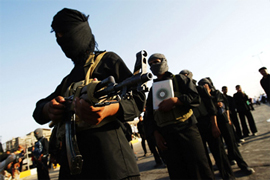Toll rises in Baghdad mosque blast
Number of dead now 87 in the single biggest attack in Iraq’s capital in two months.

The explosion, which occurred around 2pm (11:00 GMT), sent smoke billowing over buildings and rattled windows across the centre of the city.
| Your Views |
|
Bohemia, US Send us your views
Gunfire also erupted moments after the blast in the commercial area of Sinak.
The attacks follows a relatively quiet period in the capital after a curfew was imposed for four days last week in the wake of an attack on al-Askariya mosque in Samarra, north of Baghdad.
Sheik Saleh al-Haidari, the mosque’s imam, said the bomb hit worshippers as they were leaving afternoon prayers.
He said: “This attack was planned and carried out by sick souls, damaging the mosque’s outer wall and collapsing my office and the room above it.
“There are number of bodies being pulled from the rubble and a number of worshippers were killed or injured.”
Nassiriya fighting
Elsewhere, two days of fierce fighting between Iraqi police, backed by British forces, and al-Mahdi army fighters loyal to Muqtada al-Sadr, the Shia leader, killed more than 35 people and wounded around 125 others in the southern city of Nassiriya, a hospital doctor said on Tuesday.
The fighting underscored frictions between al-Sadr’s political movement and the Supreme Iraqi Islamic Council (SIIC), which have erupted into violence before and raised fears of a battle for control of Iraq’s more stable Shia southern regions.
The clashes began on Sunday night, when police attacked a Sadr office in Nassiriya in an apparent response to an attempt to kill a local police commander, who residents said was allied to the Badr Organisation, SIIC’s armed wing.
 |
| Nassiriya locals say al-Mahdi army members outnumber the police force [GALLO/GETTY] |
The hospital doctor, who declined to be identified, said many civilians were among the dead and wounded, including women and children.
Brigadier-General Abdul-Karim Khalaf, an interior ministry spokesman, put the death toll at 16 with 60 wounded. He said the interior ministry was in talks with the defence ministry about regaining control of the city.
The British military said it had flown the head of the 10th Division of the Iraqi Army by helicopter from Basra for urgent talks with the governor of Dhi Qar province, of which Nassiriya is the capital.
“We can confirm there still seems to be sporadic outbursts of trouble,” Major David Gell, a British military spokesman, said from Basra, adding that the governor had not asked British forces to intervene.
Ceasfire talks
Al-Sadr officials said their leader on Tuesday ordered his fighters to return home and not to engage the police. Bahaa al-Araji, a Sadrist legislator in Baghdad, said the Sadrists had reached a deal with the governor of Dhi Qar for a ceasefire.
Under the agreement, al-Mahdi army fighters were to withdraw from the streets of Nassiriya, along with the police and army. But residents said by mid-afternoon sporadic fighting was continuing.
Adil al-Ansari, head of al-Sadr’s local office, said: “We received an order to stop fighting. We gave this order to our people, but not to those in the front line because they are in direct contact with the police and army, who have not stopped shooting.”
A Nassiriya resident said the police appeared to be out-numbered and outgunned by al-Mahdi army fighters, who were armed with mortars, Katyusha rockets, assault rifles and rocket-propelled grenades.